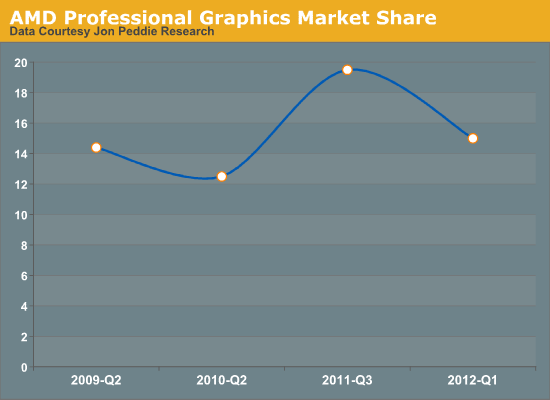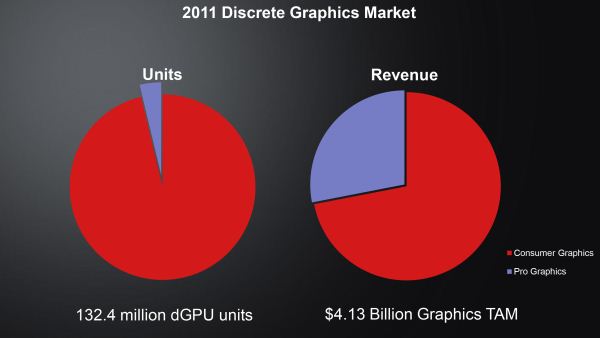The AMD FirePro W9000 & W8000 Review: Part 1
by Ryan Smith on August 14, 2012 4:00 AM ESTSetting the Scene: The Professional Graphics Market
Seeing as how this is our first professional video card review in quite some time, we wanted to spend a bit of time discussing the professional video card market in depth before diving into the features of AMD’s hardware. Because the professional graphics market is not particularly price-sensitive (unlikely the consumer market), how it operates is not particularly straightforward. Understanding the professional graphics market also sets the stage for understanding the importance of the FirePro W series; there’s more at stake than just beating NVIDIA’s cards.
The biggest reason that the professional graphics market is of great importance to NVIDIA and AMD isn’t just that it’s another market for them to sell products in, but because it’s not just another market. As we alluded to in our introduction, going by the volume of products shipped the professional graphics market is tiny. Even looking at revenue it’s far smaller than the consumer market. But what revenue hints at and what financial statements prove is that it’s profitable. Extremely profitable.
Neither AMD nor NVIDIA specifically break out their complete gross margins on a market segment basis – something that would be difficult to do since both rely on the same GPUs and R&D – but they are very straightforward in telling investors about the overall profitability of the professional market segments. To work with a simple example, take NVIDIA’s product lineup, where NVIDIA could profitably sell a GF110 GPU in the form of a GTX 580 at $500. Meanwhile the Quadro 6000 – a card containing the same GF110 GPU – was released at $5000, 10 times the price. Even after factoring in the unique costs of bringing a professional graphics product to market such as driver validation, support, and a higher individual unit cost, the professional graphics market is incredibly profitable. In the GPU market, just like most other technology markets, professionals will pay a much larger premium for specialized hardware.
The end result is that to make a significant profit in the desktop GPU market you need to hold a sizable share of both the consumer market and the professional market. The professional market will provide a low-volume, high-margin income stream, while the consumer market allows manufacturers to spread out R&D costs over a much larger number of products and to sell binned chips that would never meet professional standards.
But what happens if you don’t have a significant share of both the consumer and professional markets? Unfortunately, that would make you AMD.

Our apologies for the inconsistent data. JPR does not regularly release detailed market share data to the public
AMD’s professional graphics presence marks a continuing battle for the company. While in the consumer space they have 25% of the total market (including iGPUs) versus NVIDIA’s 15%, and in the discrete market they have 38% to NVIDIA’s 62%, in the professional graphics market they have only a 15% market share. This is better than the near-10% share they had a few years ago, but it’s below the near-20% share they reached last year, and far below where they would like to be.
As it stands AMD’s graphics division regularly turns out a small profit (in the form of operating income) every quarter, but they’re nowhere near NVIDIA’s profitability. It goes without saying that as a business AMD is always seeking to improve their profitability for their shareholders, however they also need to turn a profit to fund R&D of future products. Just as with CPU development, GPU development costs are continuing to rise with every generation, which makes the professional graphics market and its high margins all the more important. AMD is by no means in dire straits, but long-term a sub-20% market share is not where they want to be. A sub-20% market share means that AMD is struggling to stay relevant.











35 Comments
View All Comments
damianrobertjones - Tuesday, August 14, 2012 - link
Over the years I've always popped over to this page to read the latest news and especially articles yet over the last year, or maybe a bit more, the articles haven't exactly been flowing. is the site slowing down?:(
bobsmith1492 - Tuesday, August 14, 2012 - link
This engineer doesn't like the so-called "professional" cards. I think they are a rip-off. My high-end workstation computer came with a top-of-the-line Quadro and it could barely handle a second monitor. I finally got a mid-level gaming card and was much happier with its performance.A5 - Tuesday, August 14, 2012 - link
Then the card you got was broken. Even integrated graphics can handle 2D on 2 displays no problem.bobsmith1492 - Wednesday, August 15, 2012 - link
That's what I would have thought, but no. Even scrolling down an Excel document was slow, pausing every second to redraw the whole screen. Same thing when dragging a window around over a background that was "stretch to fit." Garbage! Tried modifying graphics settings, hardware acceleration on/off, Googling like mad, posts in the AT forums but no-go.wiyosaya - Tuesday, August 14, 2012 - link
100 percent agree with your assessment that the pro cards are a rip off. The chips are the same chips as in gaming cards. The only difference is a few switches in firmware that cut off options when run in gaming cards.That firmware is also developed by the same developers; I say this after having worked in a similar field where the company I worked for marketed RIP software designed to print to copiers. All the features were in the software, but customers had to pay sometimes substantially extra to enable some of those features. In my opinion, anyone who thinks that there is a separate team developing "pro" drivers is mistaken.
With a PC that has enough processing power, IMHO, most professionals will not need the "extra capabilities" that the pro cards offer over gaming cards. Perhaps the only reason a pro would need a pro card, if you believe the marketing coming out of the pro card realm, is because you are working with a model that has thousands of parts.
However, there is a recent trend to kill double precision compute power in gaming cards. IMHO, this is going to hurt graphics card makers more than it will help. It was for this reason that I avoided buying a GTX 680 and opted for a 580 instead for a recent build of mine.
nathanddrews - Tuesday, August 14, 2012 - link
Apparently it doesn't hurt them at all since they're making a lot of money with pro cards. All you have to do is show this to a CAD designer and you'l make sale:http://vimeo.com/user647522
aguilpa1 - Wednesday, August 15, 2012 - link
All these videos illustrate is that certain hardware accelerated features are turned off at the bios and software level. It is an illustration of intentional vender modifications of a piece of hardware to differentiate the two in order to improve the profit of the other.This was clearly illustrated in early versions of Quadros whereby a simple bios update would re-enable the turned off features of the consumer model. These methods may have been disabled by now by the vendor as they get wise to the ways of gamers.
rarson - Tuesday, August 14, 2012 - link
Wrong. With a professional card, you pay for both the validation and the software, neither of which are professional quality in the consumer variants."That firmware is also developed by the same developers"
Firmware and drivers are two different things, by the way.
wiyosaya - Thursday, August 16, 2012 - link
"Wrong. With a professional card, you pay for both the validation and the software, neither of which are professional quality in the consumer variants."The marketing departments have done their jobs very well or you are "pro vendor shill," IMHO as that is what the vendor wants everyone to think. As I previously stated, having been in more than one position where the companies that I worked for sell "professional" software, it is not the case.
I expect that most pro software packages will run on most gamer cards with very little difference except, perhaps, when pushing the pro software package to its absolute limit. If anyone wants to pay $4K for a $400 card, they are certainly welcome to do that. IMHO, it is a complete waste of money.
PrinceGaz - Sunday, August 19, 2012 - link
If you really are a professional graphics (or compute) user and would rather take the chance by opting for a non-validated $400 card instead of a fully-validated and backed by the hardware and software-vendor $4,000 card, then you have got your priorities wrong. That or you're being seriously underpaid for the sort of work you are doing.Your software vendor isn't going to be very impressed when you report a problem and they find the system you are running it on has a GeForce or Radeon card instead of one of the validated professional cards and driver versions supported by it!